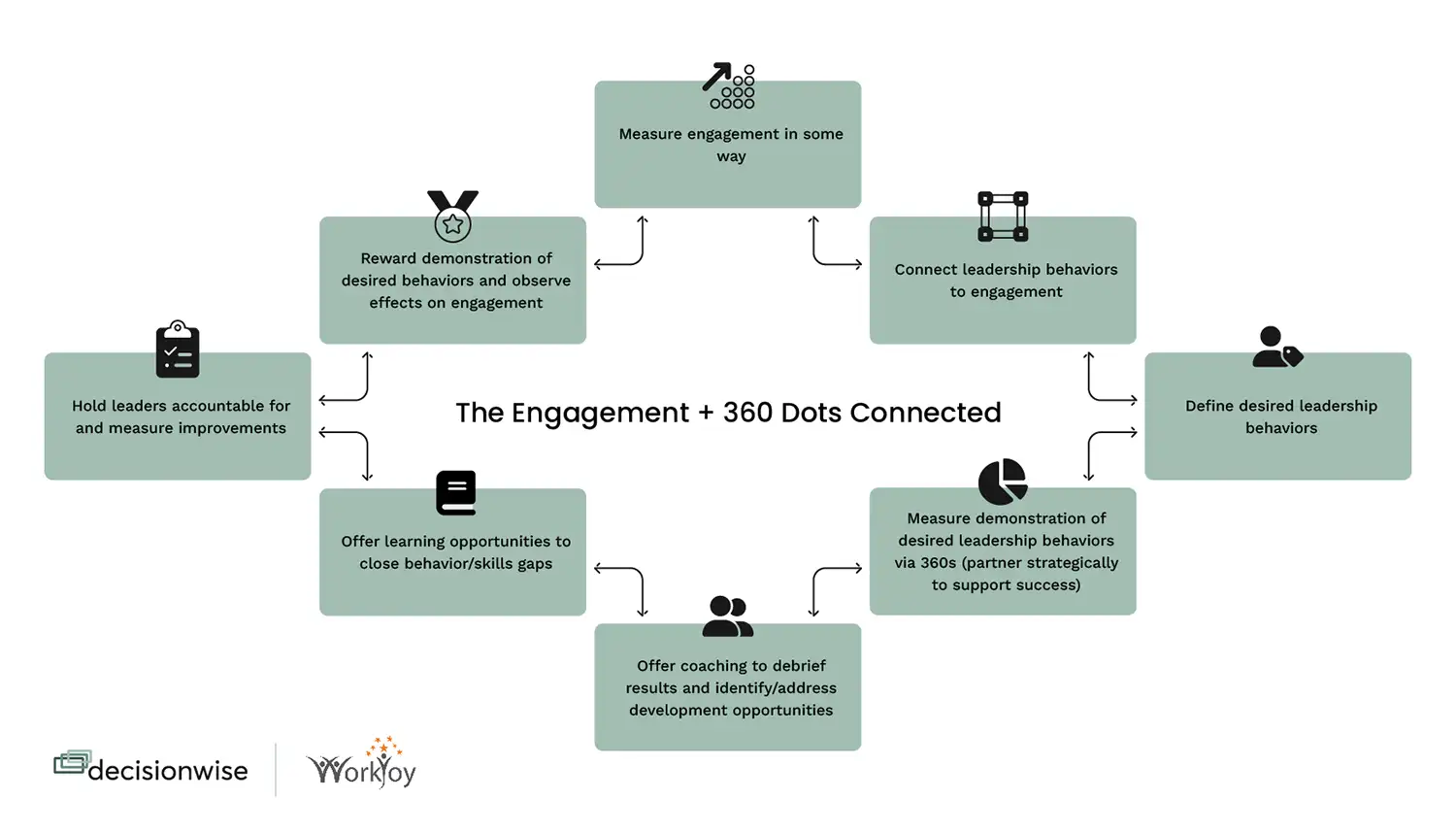By the time we reach our mid-management years in corporate land, most of us have been a recipient of or rater for a 360-feedback assessment. 360s have been around since 1940, and more than a third of workplaces (and 90%+ of Fortune 500 companies) use them. And yet, there are as many articles extolling their virtues as there are preaching their demise.
What if the 360 could move beyond performance management? What if we could use this feedback not just to connect learning and development dots but to anchor a robust leadership development approach? What if 360 feedback could be our secret weapon in the battle for engagement?
These are the questions I asked on behalf of a global eCommerce organization that incubates and manages multiple “digital first” fashion brands. The organization was investing in employee engagement, measuring it twice a year, and knew that leaders influenced their employees’ willingness to be committed, give incremental effort, and stick around. (Per Gallup research, this effect on engagement is up to 70%).
The organization’s reasoning was sound:
- If employees believe the organization is a great place to work, they likely are (or will be) more engaged.
- If leaders are demonstrating desired behaviors, they are more likely to contribute to the organization being a great place to work.
- Let’s measure these desired (and expected) behaviors and coach leaders around the gaps.
- Let’s experiment with a 360 for a holistic, multi-faceted assessment.
In late 2019, the organization recruited me to create a leadership development function, beginning with the rollout of 360s for leaders at director through senior VP levels – more than 150 across countries, functions, and businesses.
What We Did: Identify the Why
The first step was to clarify and confirm the big “why” – critical to any learning and development program, but especially to 360s. Were we assessing leaders to diagnose potential problems? Evaluate development needs? Deepen self-awareness? The answer was…yes, yes, and yes. The organization suspected there was a gap between desired and demonstrated behaviors and wanted to identify the biggest chasms to tailor remedies and prioritize starting points. Making the leaders themselves (and the leaders’ leaders) aware of the gaps would support interest in closing them.
What We Did: Transformed Desired Behaviors Into Measurable Competencies
Fortunately, the organization had learned from its surveys and identified the leadership behaviors most correlated with increased employee engagement, retention, and commitment. These behaviors were on every people manager’s development plan. Partnering with a 360 vendor, we translated the behaviors into competency statements that could flow easily into a 360 assessment.
What We Achieved: Jump-started Leadership Development
I’ll skip the weeks of survey setup, email message drafting, executive communication, stakeholder management, participant identification, and tactical program launch. We achieved significant results, including:
- 150+ 360s with leaders, including 90-minute debrief coaching conversations, between April 2020 – May 2021 (YES – during the pandemic)
- Created ongoing demand for development opportunities and deepened trust with leaders (they began asking for workshops for their teams, specific self-study resources, etc.)
- Created interest in leadership coaching
What We learned: Practical and Tactical
Our ratings – across all competencies and leaders – averaged a 4/5
It’s SO hard to escape the biases in feedback, including leniency (desire to give everyone an A), recency (“Bob did something great yesterday, and now I’m rating him, so Bob is…great!”), central tendency (aim for the middle), and the personal relationships between raters and those being rated. Despite best efforts to promote the anonymity of the process, some raters will lean positive, so they don’t make enemies of those being rated. In subsequent rollouts of the 360, we changed the rating scale to 1-4 to eliminate that middle option. Talk to your 360-vendor partner about the pros and cons of rating scales.
As we noticed this trend in our 360 waves, we doubled down on communicating the importance of comments – actionable, specific, personal written feedback. Even if the numbers didn’t tell a story, the comments could – and did.
Invest time in the debrief – most participants said they read their reports but learned much more from the conversations
Yes, 90 minutes of coaching per 360 adds up to a lot of time. But the magic happens in the conversations – it’s where ah-ha’s surface and the dots connect. 360 participants need help finding the story within the “noise” of ratings and comments, knowing which numbers and statements might be one-offs and which patterns are worthy of attention.
Coaching conversations led to more thorough development planning and more productive follow-ups with the participants’ managers. If you lack the internal capacity/capability to conduct these conversations, supplement them with external coaching support. The ROI from your 360s will justify the investment.
What We Learned: Strategic Insights
The “now what” is critical, but difficult – 360 success and ROI come from holding leaders accountable for acting on the insights.
360 feedback initiatives fail when they become surveys stuck in drawers – vs. the foundation of productive development plans and performance management discussions. We added a 360-related development goal to all participants’ goal plans. We shared updates on the 360-program progress with the executive team and gave the participants’ managers copies of the 360s (with advance communication to participants). And we followed up with participants and managers to check on the “now what” actions.
Connect the dots vs. throw spaghetti – weave 360 learnings and leadership competencies into leader-focused programming.
Humans have short memories and are attracted to the new and shiny. We watched our 360 program go from “Hey that’s cool” to “Are we still doing these” – and had to find ways of maintaining interest, commitment, and relevance. After the year-long program of 150 participants, we offered 360s to leaders who had active development plans (and tailored the competencies to specific leaders’ focus areas).
We incorporated the 360 into the inaugural “high potential” leadership development program. We brought the measured behaviors into talent reviews to support succession planning. And we rolled out leadership development content related to the measured behaviors. Not all your spaghetti will stick but celebrate and deepen what does.
Ultimately…the 360 is a tool.
Our “what if” questions at the launch of our 360-journey led to tactical, practical, and strategic insights about the assessment. Our ultimate takeaway was that the 360 is a valuable tool, one that has been field-tested and integrated into our expanding employee engagement-focused toolbox. Like with any development tool, success depends on why you use it, how you use it, and what you do with the results.
Parting thoughts
Set yourself up for 360 success by partnering with a flexible and supportive vendor and coaches who can deepen participants’ insights through conversations. Limit your participants based on your administrative (and financial) bandwidth, holding them accountable for doing something with their insights. Stay aligned with your big why, communicate achievements, and celebrate your victories.
We look forward to celebrating with you – share your success stories with us!
About the Author
Tina Schust Robinson is an experienced leadership coach and DecisionWise coaching partner who has been using 360s with clients for more than 20 years. Tina is the founder of WorkJoy, providing coaching, facilitation, and consulting services to organizations ready to unleash the potential of their humans.





